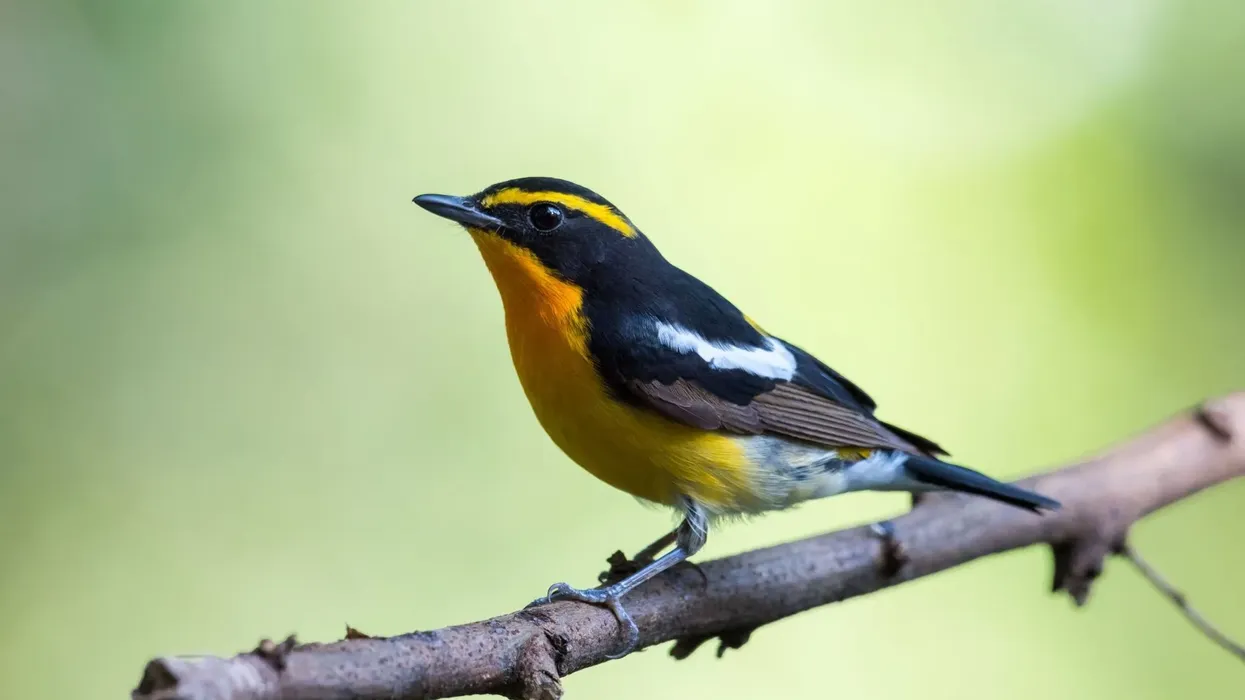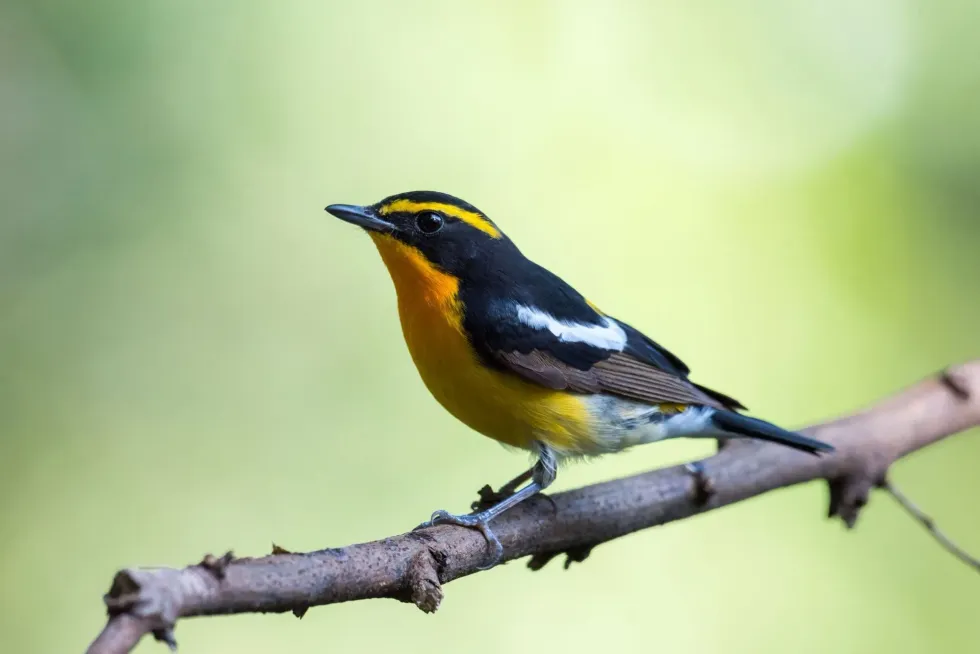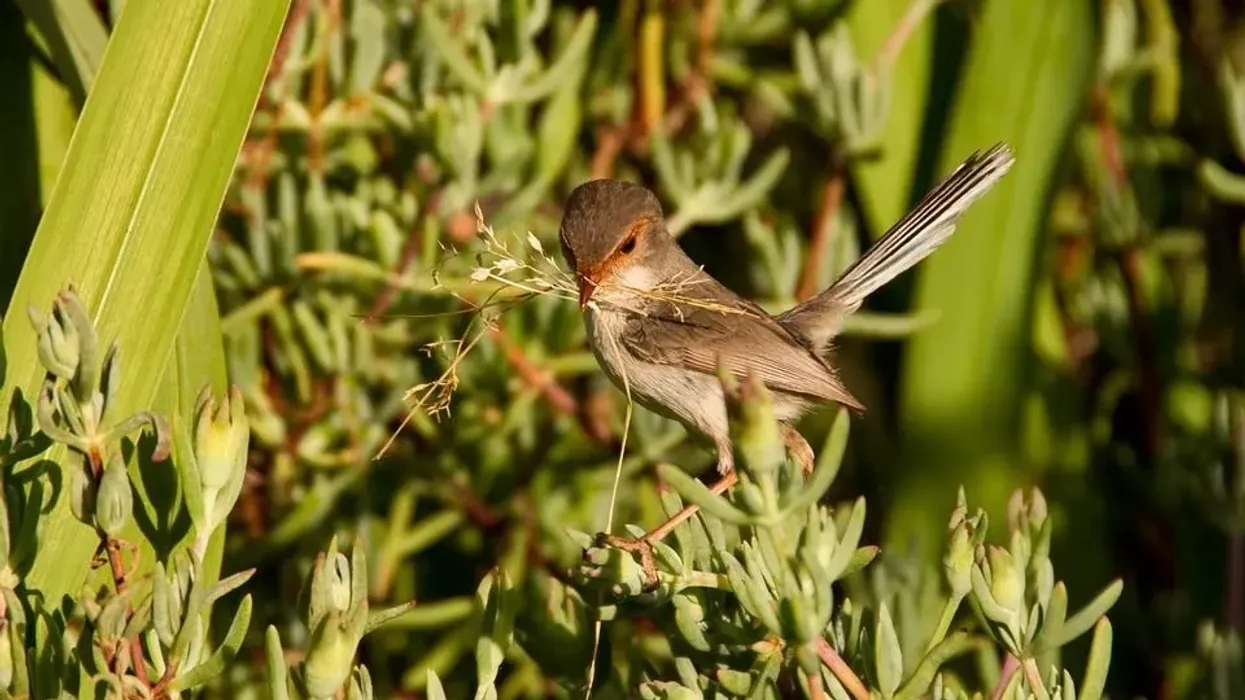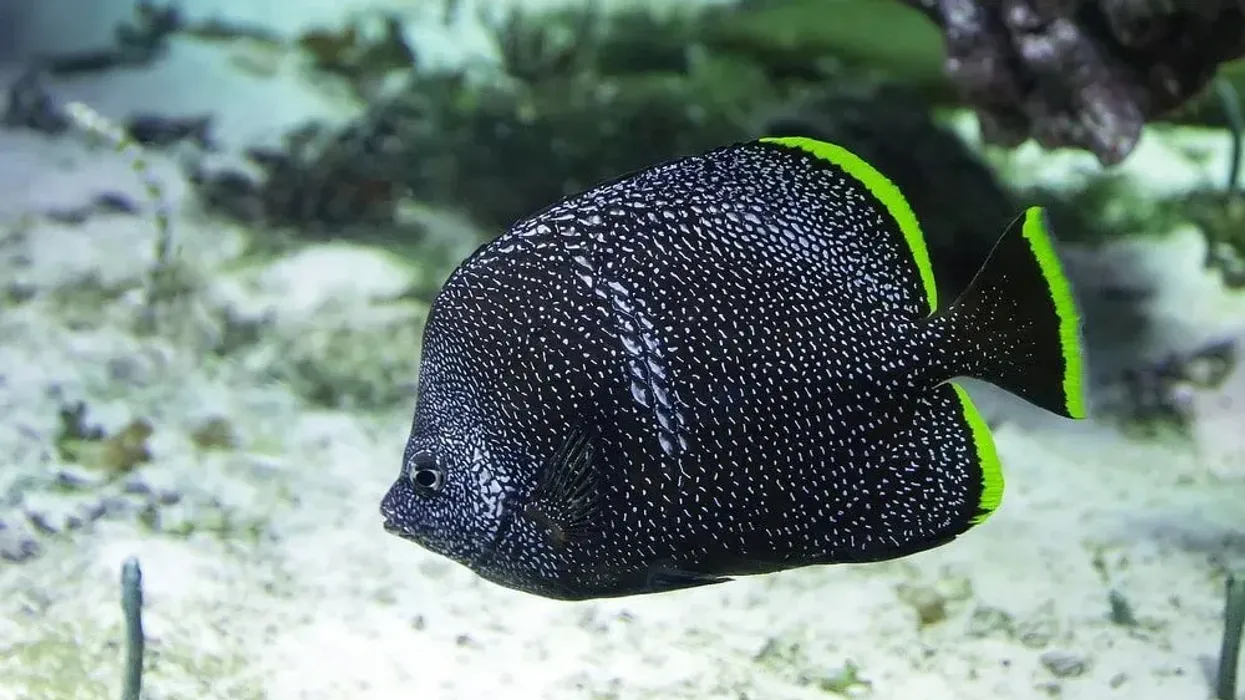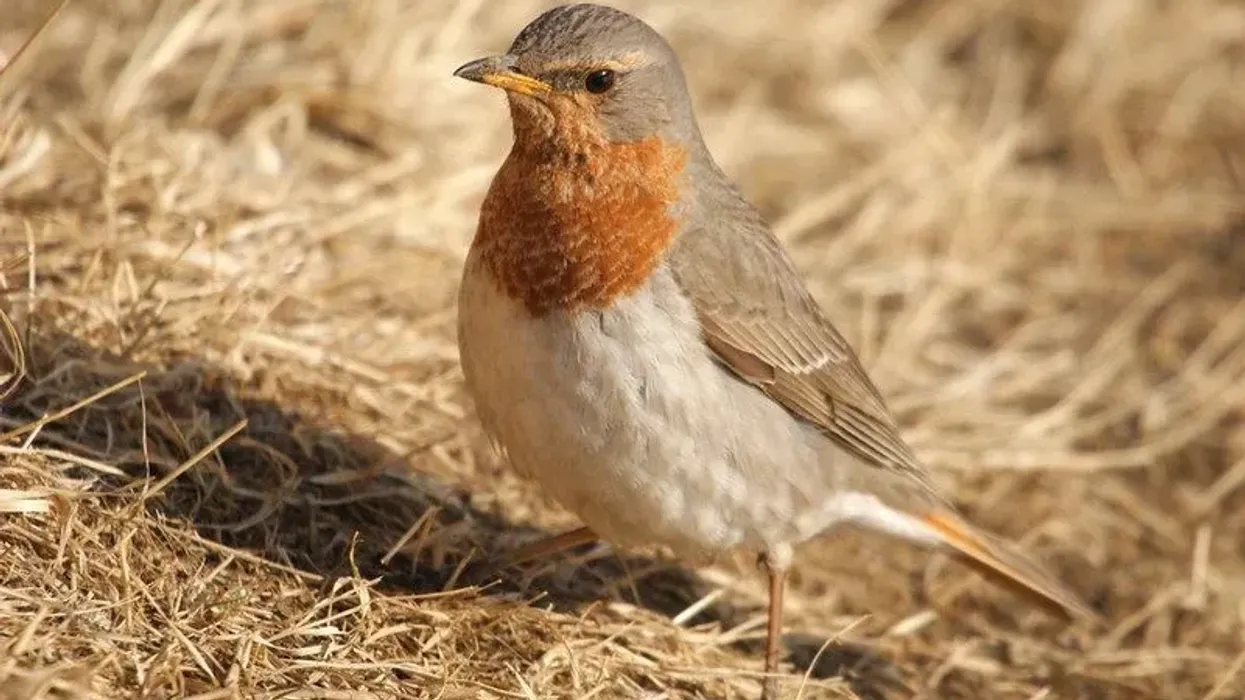The narcissus flycatcher (Ficedula narcissina) is a small bird species native to the Asian continent.
These birds are members of the flycatcher family and are renowned for the bright feathers of the male, which compared to the females, have a striking appearance.
The bright body, tail, and wings of the males are to help them in courting mates during the breeding season as female flycatchers have the privilege of choosing a suitable mate to breed with.
This difference in feathers results in the female looking much duller in comparison as they have no worries about attracting mates and have to just make their nest and lay eggs.
Narcissus flycatchers are smaller than the common sparrow and are not easily visible in the dense habitats that range from a variety of mixed forests. It is, however, possible to locate these birds in parks and gardens as these areas are part of their migratory route.
Young juveniles are almost similar to the female, which makes it tough to differentiate them.
If you like these narcissus flycatcher facts, be sure to check out facts about bee-eater and palm cockatoo too!
Narcissus Flycatcher Interesting Facts
What type of animal is a narcissus flycatcher?
The narcissus flycatcher bird is a small bird species that belong to the vast flycatcher family. These birds are well-known for their two-toned eyering that is a common form of identification that the female narcissus has.
Previously, these birds were conspecific with the yellow-rumped flycatcher (F. zanthopygia), but are now conspecific with the green-backed flycatcher (F. elisae) and Ryuku flycatcher (F. owstoni).
The nominate race of F. n. narcissina are found in the range of East Asia from Sakhalin to the Philippines, covering Korea, China, and Taiwan, and the F. n. owstoni have a migratory range based in the Ryuku Islands in Japan with both breeding and non-breeding populations found thoroughly distributed in Southeast Asia.
What class of animal does a narcissus flycatcher belong to?
Narcissus flycatcher birds belong to the Aves class of animals and are members of the family of flycatchers.
How many narcissus flycatchers are there in the world?
The population distribution of this species is vast in nature as they are commonly found in the Sakhalin Island, and are widespread throughout Japan. An estimated breeding population of 100-100,000 is found in Russia, and a furthermore 10,000-100,000 breeding pairs are found in Japan.
Taking into consideration the scattered population throughout countries like China, South Korea, Taiwan, and other parts of Southeast Asia, the breeding and non-breeding population of these birds is estimated to range between 20,000-400,000 individuals.
Since these birds are highly migratory during the winter season, small vagrant populations can be found in Australia in the south and Alaska in the north.
Where does a narcissus flycatcher live?
The narcissus flycatcher (Ficedula narcissina) has a vast range of habitats due to the fact that these birds are migratory in nature. The narcissus flycatcher range map can be divided into the breeding range, non-breeding range, and vagrant range.
Their breeding range is usually in the coastal Ussuriland, Sakhalin to the north, South Kuril Island, and Japan, mostly to the south of the Kyushu region.
The non-breeding range of this bird is South Korea, North Korea, Taiwan, Vietnam, East China, Java, and Bali.
The vagrant range consists of Alaska in the north and Australia in the south.
What is a narcissus flycatcher's habitat?
The narcissus flycatcher inhabits temperate and subtropical forest regions that consist of conifer, broadleaf, and deciduous regions. These flycatchers can be found in a vast range of habitats during their migration period and can be found in areas like coastal scrubs, parks, gardens, and mangroves.
Who do narcissus flycatchers live with?
Narcissus flycatchers are usually solitary in nature but do occur in pairs sometimes. These birds do like to occur in flocks of mixed species with both the males and females of these species being territorial in nature.
How long does a narcissus flycatcher live?
The lifespan of the narcissus flycatcher (Ficedula narcissina) is currently unknown.
How do they reproduce?
The sexual maturity period of either the male or the female is currently known. However, it is known that the breeding season occurs between May to July. Like most members of the flycatcher family, the males do not participate in incubation or nest building.
The females of these birds species are responsible for nesting and create nests in tree cavities, trunks, or crevices. The nest is cup-shaped and is decorated with leaves and plant fibers and is created at a height of 4.9-14.7 ft (1.5-4.4 m) above ground.
After mating with the males, the females lay three to five eggs that are white in color and have red markings. Incubation of the eggs is done by the females, with the males taking part in rearing and feeding the young.
What is their conservation status?
The narcissus flycatcher (Ficedula narcissina) is listed as a species of Least Concern on the IUCN Red List due to the vast population range in the north, south, and the east of the globe.
Narcissus Flycatcher Fun Facts
What do narcissus flycatchers look like?
The breeding plumage of a male narcissus flycatcher has the bird donning a black crown and mantle, which is followed by a bright orange throat with chest and underparts that are paler in comparison. Males have orange-yellow eyebrows and black wings that are tipped with a white wing patch on the inner greater upperwing-coverts.
They have an orange-yellow rump too with a black tail.
Non-mating males lack the white wing patch along with the black crown and mantle and have a plumage that is duller in comparison to the breeding male.
The female's plumage lacks the orange throat, yellow rump, and yellowish-orange supercilium that is found on the coverts, along with the deep yellow rump and uppertail-coverts. They also lack the yellowish-orange color palette that runs down from the chin to the breast and the paler yellow flanks.
Females have a rusty gray-brown crown and face, with a two-toned eyering. The upperparts are tinged olive, and the rump is a tone of yellowish olive, with brown uppertail-coverts and outer tail feathers.
The side of the throat and breast is brown or whitish. The breast is suffused with an olive green color tone and yellow undertail-coverts.

How cute are they?
These birds are super cute to look at, especially the males because of their brightly colored bodies!
How do they communicate?
These birds communicate with each other through vocal and visual methods. Breeding males can often be heard singing to attract females.
How big is a narcissus flycatcher?
The adult narcissus flycatcher (Ficedula narcissina) reaches a maximum body size of 5.1-5.3 in (13–13.4 cm). This bird is larger than the rufous hummingbird that grows up to 2.8-3.6 in (7.1-9.1 cm).
How fast can a narcissus flycatcher fly?
The flight speed of the narcissus flycatcher is unknown.
How much does a narcissus flycatcher weigh?
These lightweight birds weigh between 0.3-0.4 oz (8.5–11.3 g).
What are the male and female names of the species?
Neither the male nor the female narcissus flycatcher has a specific name assigned to it.
What would you call a baby narcissus flycatcher?
A narcissus flycatcher baby is called a chick. The narcissus flycatcher fledgling is fed and cared for by both the male and female parents.
Juveniles are much like the adult female flycatcher and are duller in comparison to the males and lack the orange-yellow plumage as well as the black crown and mantle. The upperparts are brown and lack the yellow color tone that the plumage of the male adult has.
What do they eat?
The diet of this bird is currently not known well enough to specify what they eat specifically. However, they have been recorded eating caterpillars and small invertebrates along with berries.
Are they poisonous?
No, they are not poisonous.
Would they make a good pet?
No, the narcissus flycatcher (Ficedula narcissina) is a wild bird which makes it unsuitable for captive life.
Did you know...
Common predators of the narcissus flycatcher are cat and owl species.
A group of flycatchers is known as an outfield or zipper.
How did narcissus flycatchers get their name?
The narcissus flycatcher (Ficedula narcissina) gets its name from the yellow color of many Narcissus flower species.
What is unique about narcissus flycatchers?
The narcissus flycatcher (Ficedula narcissina) is one of the bird species in which the male and the female are completely different from one another as they have a vast difference in their feathers. Even the male birds are different from each other as they have a distinct breeding plumage that can be used to separate them from one another.
Here at Kidadl, we have carefully created lots of interesting family-friendly animal facts for everyone to discover! For more relatable content, check out these yellow-headed caracara facts and black caracara facts for kids.
You can even occupy yourself at home by coloring in one of our free printable least flycatcher coloring pages.
Second image by Kuribo

